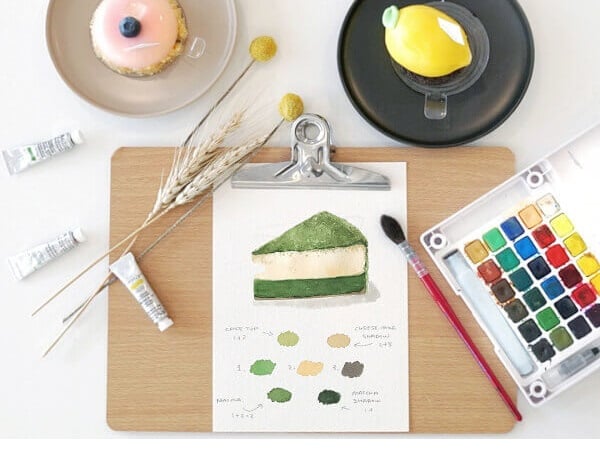In this story:
Spoiler alert! If you'd like to discover the magic of terrarium making for yourself, go ahead and book yourself in, and read no further.
But if you're curious about what exactly happens in a terrarium workshop, I'll be sharing my personal experience with you in detail.
Entree
I stepped into the Merchant and Green floristry, where the walls are adorned with flowers and shrubs of all kinds, ranging from classics like roses and tulips, as well as Australian natives, through to more exotic (at least for me) flora like cotton. I also learned that there was a Happy Plant in the corner, as well as a Mother-in-laws-tongue (yes, those are really their names! Interesting names for interesting plants. Scientifically, they are Dracaena sanderiana, and Sanseveria respectively).
The space had a relaxing vibe. Perfect for stopping to smell the roses (yes, I did that literally too). A table sat in the centre of the room, on top of which were neatly organised terrarium ingredients, giving me a sneak glimpse into the fun ahead.
I was greeted by Chris and Mitch from the Merchant and Green team, as well as the other students. Our hosts offered us beverages, and we got to know everyone through a bit of light conversation.
We flipped through a little book that Chris had recently acquired, all about terrariums. It reminded me of a cookbook, with recipes for the various types of terrariums, containing detailed lists of ingredients, preparation steps, as well as inspiring and appetising photos.
We put on our aprons, and dove eagerly into our first course.

Second course
Chris showed us the various glass containers we could build our terrariums in. We opted for large circular 'fishbowl' vases, though also available were triangular prisms (a bit more challenging), as well as smaller spherical containers, which can be hung. For those who have a bit more time to spare in a more advanced class, larger terrarium containers are a great choice for indulgence - they allow for more plants, and are perfect for events which you don't really want to end too early (think hen's parties and other special occasions, or a fun team outing).
Chris explained that we'd be building up our terrarium in layers, and the purpose of each layer. We also saw a finished terrarium, 'one prepared earlier', to get a better sense of the end goal.
The first layer is foundation of stones, which encourages sufficient drainage for our little ecosystems. We each chose from smooth white pebbles, river stones of assorted colours and shapes, and smaller grey stones - you could build this layer with one or a combination of these, with each stone type providing a different aesthetic.
Of course, there's a bit of finesse required - it isn't just about dumping stones haphazardly into a bowl! The layers have to be of the right thickness and elevation, to ensure that the ecosystem you're building is conducive to healthy plant life, and to ensure that you end up with a visually appealing terrarium. Chris and Mitch made it all easy though, with their detailed instructions and demonstrations. They also gave plenty of one on one advice (and hands-on help) where needed, while still giving us plenty of space to play and explore by ourselves.
Third course
Next up was a layer of special moss. The moss plays a crucial role in the terrarium, holding any water you put in, to ensure that your little plants can drink up just the way they like to.
The moss came in stringy brown fibres, and smelled very earthy, and reminded me of a forest's scent.
We made a little mattress with this moss, which was soft and springy, in contrast to the hard rocks just beneath. My 'layer cake' was starting to take shape!
Responding to questions, Chris gave some advice on how to water our terrariums, and the best position(s) in our living spaces for them to thrive. We also got to learn a bit about the history of terrariums, on how they came about. Chris was a great conversationalist, and kept us engaged throughout.

Learn more about making terrariums here.
Fourth course
Next, we added a layer of soil, spooning it generously into our vases.
Then Mitch brought out the stars of the show - a tray of petite succulents. There was a wide variety to choose from - short, tall, spiky, smooth, dark, light. On this day, there were over 30 plants to choose from. They reminded me of petit fours, due to their size, variety, and cuteness. Some reminded me of a blossoming lotus or camellia, with their intricate and petal-like leaves.
We had a hard time choosing from that feast of options, there were just too many pretty choices (and the plants change with every workshop, so no two workshops are exactly the same). Chris gave us some helpful advice as to which plants would best suit each of us. For example, some plants are slightly harder to maintain (I avoided those), while some plants pair particularly well with others.
We eventually settled on our choices (I picked out a tall 'jellybean' shrub, as well as a unique succulent with pink-tinged leaves), and gently shook the plants free of their little pot homes. We trimmed their roots down, so that they would fit comfortably into the soil layer that we had just laid down. The plants are quite delicate, and in some cases a few leaves fell off, but not to worry - Chris showed us how you can actually grow new plants from these leaves, using just a moist paper towel as their initial incubator.
Then came the planting. Just like normal planting, just in miniature form. We dug out tiny spaces for the roots of our plants, snuggled them in, and back-filled with soil to ensure that they would be nice and secure, and be able to pass the 'wobble test'.

Dessert
They saved the best for last. It was now time to put our finishing touches on our terrariums. The icing on the cake!
Chris showed us a few styling options, and gave us a few ideas.
Would we make a little Zen garden, with a clean and symmetric appearance?
Or a natural landscape, one you might find by a riverside?
With perhaps rolling hills and gentle valleys, to give more depth to our landscapes?
We had a wide variety of stones to work with, from large 'feature' stones of various colours, sizes and textures, to the smaller stones that we used for layering before, as well as some mosses.
I sprinkled a fine gravel-like mix to cover the soil, and accentuated it with a larger white pebble, as well as a few smaller coloured ones, somewhat randomly scattered, for a natural and contemporary look. I got lost in the moment - it was so much fun designing and playing with my miniature garden.
This was the part where you could be really creative and try out different ideas. Just like a chef would dab at a plate with a cloth to clean up its appearance before serving, we too dabbed and finessed to finish off.
It was incredible to see everyone else's finished terrariums. From the same set of ingredients, we had each created very different looking enclosed gardens (though all of them looked great).

The whole experience was a great chance to just take some time for myself, to get away from technology and closer to nature.
If my story sparked your appetite, go ahead and attend one of our future terrarium classes. The team at Merchant and Green also provide lovely workshops on making Kokedama (Japanese-inspired moss balls), as well as flower arranging with Australian natives, and with seasonal blooms.
The classes are perfect for individuals, as well as couples, and larger groups.
Until next time!
Iain for the ClassBento team




































